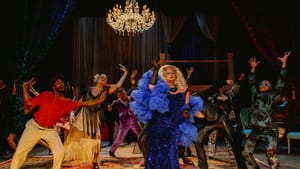Stay in the Loop
BSR publishes on a weekly schedule, with an email newsletter every Wednesday and Thursday morning. There’s no paywall, and subscribing is always free.
A deconstructed drag
EgoPo presents Mae West’s The Drag, adapted by Thomas Choinacky and AZ Espinoza

The word “essential” gets thrown around a lot when discussing theater, often speciously, but it absolutely applies to EgoPo Classic Theater’s Queer Revolutions project. At a time when queer and trans perspectives seem dangerously marginalized, devoting a full season to the broad spectrum of LGBTQ+ experience does feel, well, revolutionary. So it gives me no pleasure to report that the first offering, The Drag, unfortunately lives up to its title.
Yes, the performance culminates in a sweeping drag ball that comes across as joyous and life-affirming. But, more often than not, this high-handed and tonally inconsistent entertainment just feels like a slog.
Daring but outdated
The Drag shares its title with a 1927 play by actor and theatrical impresario Mae West, and EgoPo describes this production as a “reworking” of the original text. (The adaptation is by local Philadelphia artists Thomas Choinacky and AZ Espinoza.) West’s melodrama dealt with topics deemed degenerate by society at the time, including queerness, gender expansiveness, adultery, and self-harm. It goes without saying that a work created nearly 100 years ago likely won’t share the enlightened perspective of our modern age, but everyone should respect and acknowledge West’s daring forward thinking, as well as her collaboration with queer artists of the time.
The authors and company of The Drag clearly have some admiration for the source material. After beginning the performance in earnest—briefly, the plot centers on a closeted businessman whose attempts to subvert his queer desires lead to tragedy—the actors begin breaking the fourth wall, talking to themselves and the audience. They discuss how they do and don’t see themselves in West’s text, how some of her outdated vocabulary and ideas are harmful, and how they wish they could expand the history of the play to feel more inclusive.
Smug interruptions
Although I fundamentally disapprove of applying the morals of the present to the art of the past, I understand the impulse to question whether a piece that might do more harm than good deserves to remain in the spotlight. But the staged interjections that break away from The Drag as a play carry with them a certain undeniable smugness, as though the performers cannot wait to turn their noses up at West’s well-intentioned, but perhaps lacking, attempt to center a queer narrative. The subtext—which usually feels more like just text—is that little value remains in historical works unless we make them align perfectly with our current experience.
Even more importantly, from an audience’s perspective, it doesn’t make for a compelling performance. The forced conversations—no doubt genuine but obviously scripted—sound like what you might hear in an early rehearsal as actors work their way into the material. There’s a reason why actors love the rehearsal process and audience members prefer a finished product.
Deconstructing The Drag
When the production does focus on the West scenes, the bawdy comedy that defined her style emerges with intermittent success. Director Rebecca Wright harnesses a broad spectrum of personalities, some of whom are better suited for the exaggerated period style than others. (I particularly enjoyed Chris Davis as a hilariously laconic pair of leaping butlers, and Donovan Lockett as the starchy father of the play’s central character.) But works in this genre rely on hairpin turns of tone, and that’s not something the company reliably achieves—especially as they continue to interrupt the action with injections of earnestness.
The production itself makes handsome use of the Christ Church performance space, with a swanky set by Chris Haig and eye-catching period costumes by Ilycia Buffaloe. And the ballroom culmination, with choreography by Paule Turner, offers everything you could wish for with regard to queer joy. But to be given the opportunity to present a historically and thematically important work from the past and instead choose to spend your running time pedantically deconstructing it feels like a missed opportunity.
What, When, Where
The Drag. By Mae West, adapted by Thomas Choinacky and AZ Espinoza; directed by Rebecca Wright. $20-$38. Through February 9, 2025, at Christ Church Neighborhood House, 20 N American Street, Philadelphia. (267) 273-1414 or egopo.org.
Accessibility
Christ Church Neighborhood House is a wheelchair-accessible venue.
Sign up for our newsletter
All of the week's new articles, all in one place. Sign up for the free weekly BSR newsletters, and don't miss a conversation.

 Cameron Kelsall
Cameron Kelsall